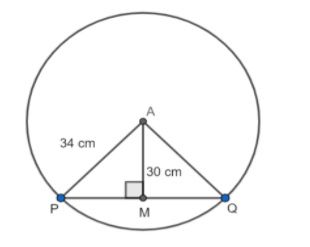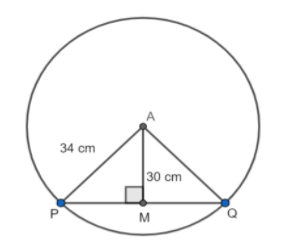
In fig. point A is a center of a circle AP = 34 cm, A is the center of a circle, AM = 30 cm. If \[AM\bot PQ\] , find the length of the chord PQ.


Answer
574.8k+ views
Hint: In the \[\Delta AMP\] , we have AM = Perpendicular = 30 cm, AP = Hypotenuse = 34 cm, PM = Base, and \[\angle AMP=90{}^\circ \] . Since the line segment, AM is perpendicular to the chord PQ so, we can apply the Pythagoras theorem in \[\Delta AMP\] . We know the Pythagoras theorem, \[{{\left( Hypotenuse \right)}^{2}}={{\left( Perpendicular \right)}^{2}}+{{\left( Base \right)}^{2}}\] . Now, apply the Pythagoras theorem in the \[\Delta AMP\] and get the length of PM. We know the property that the perpendicular line drawn from the center to a chord of a circle bisects the chord. Here, AM is perpendicular to the chord PQ. So, the line AM bisects the chord PQ. M is the midpoint of the chord PQ. Therefore, \[PQ=2PM\] . Now, using the length of PM, get the length of PQ.
Complete step-by-step answer:
According to the question, we have a circle in which there is a chord PQ. The line segment AM drawn from the center A to the chord PQ such that AM is perpendicular to the chord PQ.
From the figure, we have
The length of the line segment AP = 34 cm …………………………………(1)
The length of the line segment AM = 30 cm …………………………………(2)
In the \[\Delta AMP\] , we have
AM = Perpendicular = 30 cm ………………………………………….(3)
AP = Hypotenuse = 34 cm …………………………………………..(4)
PM = Base ………………………………………(5)
\[\angle AMP=90{}^\circ \] ……………………………………….(6)
Since the line segment, AM is perpendicular to the chord PQ so, we can apply the Pythagoras theorem in \[\Delta AMP\] .
We know the Pythagoras theorem,
\[{{\left( Hypotenuse \right)}^{2}}={{\left( Perpendicular \right)}^{2}}+{{\left( Base \right)}^{2}}\] ………………………………………………….(7)
Now, from equation (3), equation (4), equation (5), and equation (7), we have
\[\begin{align}
& \Rightarrow {{\left( 34 \right)}^{2}}={{\left( 30 \right)}^{2}}+{{\left( PM \right)}^{2}} \\
& \Rightarrow 1156=900+{{\left( PM \right)}^{2}} \\
& \Rightarrow 1156-900={{\left( PM \right)}^{2}} \\
& \Rightarrow 256={{\left( PM \right)}^{2}} \\
& \Rightarrow \sqrt{256}=PM \\
& \Rightarrow 16=PM \\
\end{align}\]
The length of the line segment PM is equal to 16 cm ……………………………….(8)
We know the property that the perpendicular line drawn from the center to a chord of a circle bisects the chord ……………………………………..(9)
Here, the line segment AM is also perpendicular to the chord PQ. Using the property shown in equation (9), we can say that the line AM bisects the chord PQ. It means that the point M is the midpoint of the chord PQ.
Since M is the midpoint of the chord PQ so,
\[PQ=2PM\] ……………………………………….(10)
From equation (8), we have the length of the line segment PM.
Now, on substituting PM by 16 cm in equation (10), we get
\[PQ=2\left( 16\,cm \right)=32\,cm\]
Therefore, the length of the line segment PQ is equal to 32 cm.
Note: We can also solve this question without using the property that the perpendicular line drawn from the center to a chord of a circle bisects the chord.

In the \[\Delta AMP\] , we have
AM = Perpendicular = 30 cm ………………………………………….(1)
AP = Hypotenuse = 34 cm …………………………………………..(2)
PM = Base ………………………………………(3)
\[\angle AMP=90{}^\circ \] ……………………………………….(4)
Since the line segment, AM is perpendicular to the chord PQ so, we can apply the Pythagoras theorem in \[\Delta AMP\] .
We know the Pythagoras theorem,
\[{{\left( Hypotenuse \right)}^{2}}={{\left( Perpendicular \right)}^{2}}+{{\left( Base \right)}^{2}}\] ………………………………………………….(5)
Now, from equation (1), equation (2), equation (3), and equation (5), we have
\[\begin{align}
& \Rightarrow {{\left( 34 \right)}^{2}}={{\left( 30 \right)}^{2}}+{{\left( PM \right)}^{2}} \\
& \Rightarrow 1156=900+{{\left( PM \right)}^{2}} \\
& \Rightarrow 1156-900={{\left( PM \right)}^{2}} \\
& \Rightarrow 256={{\left( PM \right)}^{2}} \\
& \Rightarrow \sqrt{256}=PM \\
\end{align}\]
\[\Rightarrow 16=PM\] ……………………………………….(6)
We know the sum of the linear pair of angles is always \[180{}^\circ \] .
Since \[\angle AMP\] and \[\angle AMQ\] are linear pairs of angles so, the summation of the angles \[\angle AMP\] and \[\angle AMQ\] is \[180{}^\circ \] .
\[\angle AMP+\angle AMQ=180{}^\circ \] …………………………………………………(7)
Now, from equation (4) and equation (7), we get
\[\begin{align}
& \Rightarrow 90{}^\circ +\angle AMQ=180{}^\circ \\
& \Rightarrow \angle AMQ=180{}^\circ -90{}^\circ \\
& \Rightarrow \angle AMQ=90{}^\circ \\
\end{align}\]
\[AP=AQ=16\,cm\] (radius of a circle is always equal)
Now, in the \[\Delta AMQ\] , we have
AM = Perpendicular = 30 cm ………………………………………….(8)
AQ = Hypotenuse = 34 cm …………………………………………..(9)
MQ = Base ………………………………………(10)
\[\angle AMQ=90{}^\circ \] ……………………………………….(11)
We know the Pythagoras theorem,
\[{{\left( Hypotenuse \right)}^{2}}={{\left( Perpendicular \right)}^{2}}+{{\left( Base \right)}^{2}}\] ………………………………………………….(12)
Now, from equation (8), equation (9), equation (10), and equation (12), we have
\[\begin{align}
& \Rightarrow {{\left( 34 \right)}^{2}}={{\left( 30 \right)}^{2}}+{{\left( MQ \right)}^{2}} \\
& \Rightarrow 1156=900+{{\left( MQ \right)}^{2}} \\
& \Rightarrow 1156-900={{\left( MQ \right)}^{2}} \\
& \Rightarrow 256={{\left( MQ \right)}^{2}} \\
& \Rightarrow \sqrt{256}=MQ \\
\end{align}\]
\[\Rightarrow 16=MQ\] ……………………………………….(13)
From the figure, we can see that
\[PQ=PM+MQ\] ………………………………………..(14)
Now, from equation (6), equation (13), and equation (14), we have
\[PQ=16\,cm+16\,cm=32\,cm\] .
Therefore, the length of the line segment PQ is equal to 32 cm.
Complete step-by-step answer:
According to the question, we have a circle in which there is a chord PQ. The line segment AM drawn from the center A to the chord PQ such that AM is perpendicular to the chord PQ.
From the figure, we have
The length of the line segment AP = 34 cm …………………………………(1)
The length of the line segment AM = 30 cm …………………………………(2)
In the \[\Delta AMP\] , we have
AM = Perpendicular = 30 cm ………………………………………….(3)
AP = Hypotenuse = 34 cm …………………………………………..(4)
PM = Base ………………………………………(5)
\[\angle AMP=90{}^\circ \] ……………………………………….(6)
Since the line segment, AM is perpendicular to the chord PQ so, we can apply the Pythagoras theorem in \[\Delta AMP\] .
We know the Pythagoras theorem,
\[{{\left( Hypotenuse \right)}^{2}}={{\left( Perpendicular \right)}^{2}}+{{\left( Base \right)}^{2}}\] ………………………………………………….(7)
Now, from equation (3), equation (4), equation (5), and equation (7), we have
\[\begin{align}
& \Rightarrow {{\left( 34 \right)}^{2}}={{\left( 30 \right)}^{2}}+{{\left( PM \right)}^{2}} \\
& \Rightarrow 1156=900+{{\left( PM \right)}^{2}} \\
& \Rightarrow 1156-900={{\left( PM \right)}^{2}} \\
& \Rightarrow 256={{\left( PM \right)}^{2}} \\
& \Rightarrow \sqrt{256}=PM \\
& \Rightarrow 16=PM \\
\end{align}\]
The length of the line segment PM is equal to 16 cm ……………………………….(8)
We know the property that the perpendicular line drawn from the center to a chord of a circle bisects the chord ……………………………………..(9)
Here, the line segment AM is also perpendicular to the chord PQ. Using the property shown in equation (9), we can say that the line AM bisects the chord PQ. It means that the point M is the midpoint of the chord PQ.
Since M is the midpoint of the chord PQ so,
\[PQ=2PM\] ……………………………………….(10)
From equation (8), we have the length of the line segment PM.
Now, on substituting PM by 16 cm in equation (10), we get
\[PQ=2\left( 16\,cm \right)=32\,cm\]
Therefore, the length of the line segment PQ is equal to 32 cm.
Note: We can also solve this question without using the property that the perpendicular line drawn from the center to a chord of a circle bisects the chord.

In the \[\Delta AMP\] , we have
AM = Perpendicular = 30 cm ………………………………………….(1)
AP = Hypotenuse = 34 cm …………………………………………..(2)
PM = Base ………………………………………(3)
\[\angle AMP=90{}^\circ \] ……………………………………….(4)
Since the line segment, AM is perpendicular to the chord PQ so, we can apply the Pythagoras theorem in \[\Delta AMP\] .
We know the Pythagoras theorem,
\[{{\left( Hypotenuse \right)}^{2}}={{\left( Perpendicular \right)}^{2}}+{{\left( Base \right)}^{2}}\] ………………………………………………….(5)
Now, from equation (1), equation (2), equation (3), and equation (5), we have
\[\begin{align}
& \Rightarrow {{\left( 34 \right)}^{2}}={{\left( 30 \right)}^{2}}+{{\left( PM \right)}^{2}} \\
& \Rightarrow 1156=900+{{\left( PM \right)}^{2}} \\
& \Rightarrow 1156-900={{\left( PM \right)}^{2}} \\
& \Rightarrow 256={{\left( PM \right)}^{2}} \\
& \Rightarrow \sqrt{256}=PM \\
\end{align}\]
\[\Rightarrow 16=PM\] ……………………………………….(6)
We know the sum of the linear pair of angles is always \[180{}^\circ \] .
Since \[\angle AMP\] and \[\angle AMQ\] are linear pairs of angles so, the summation of the angles \[\angle AMP\] and \[\angle AMQ\] is \[180{}^\circ \] .
\[\angle AMP+\angle AMQ=180{}^\circ \] …………………………………………………(7)
Now, from equation (4) and equation (7), we get
\[\begin{align}
& \Rightarrow 90{}^\circ +\angle AMQ=180{}^\circ \\
& \Rightarrow \angle AMQ=180{}^\circ -90{}^\circ \\
& \Rightarrow \angle AMQ=90{}^\circ \\
\end{align}\]
\[AP=AQ=16\,cm\] (radius of a circle is always equal)
Now, in the \[\Delta AMQ\] , we have
AM = Perpendicular = 30 cm ………………………………………….(8)
AQ = Hypotenuse = 34 cm …………………………………………..(9)
MQ = Base ………………………………………(10)
\[\angle AMQ=90{}^\circ \] ……………………………………….(11)
We know the Pythagoras theorem,
\[{{\left( Hypotenuse \right)}^{2}}={{\left( Perpendicular \right)}^{2}}+{{\left( Base \right)}^{2}}\] ………………………………………………….(12)
Now, from equation (8), equation (9), equation (10), and equation (12), we have
\[\begin{align}
& \Rightarrow {{\left( 34 \right)}^{2}}={{\left( 30 \right)}^{2}}+{{\left( MQ \right)}^{2}} \\
& \Rightarrow 1156=900+{{\left( MQ \right)}^{2}} \\
& \Rightarrow 1156-900={{\left( MQ \right)}^{2}} \\
& \Rightarrow 256={{\left( MQ \right)}^{2}} \\
& \Rightarrow \sqrt{256}=MQ \\
\end{align}\]
\[\Rightarrow 16=MQ\] ……………………………………….(13)
From the figure, we can see that
\[PQ=PM+MQ\] ………………………………………..(14)
Now, from equation (6), equation (13), and equation (14), we have
\[PQ=16\,cm+16\,cm=32\,cm\] .
Therefore, the length of the line segment PQ is equal to 32 cm.
Recently Updated Pages
A man running at a speed 5 ms is viewed in the side class 12 physics CBSE

The number of solutions in x in 02pi for which sqrt class 12 maths CBSE

State and explain Hardy Weinbergs Principle class 12 biology CBSE

Write any two methods of preparation of phenol Give class 12 chemistry CBSE

Which of the following statements is wrong a Amnion class 12 biology CBSE

Differentiate between action potential and resting class 12 biology CBSE

Trending doubts
What are the major means of transport Explain each class 12 social science CBSE

Which are the Top 10 Largest Countries of the World?

Draw a labelled sketch of the human eye class 12 physics CBSE

Explain sex determination in humans with line diag class 12 biology CBSE

Explain sex determination in humans with the help of class 12 biology CBSE

Differentiate between homogeneous and heterogeneous class 12 chemistry CBSE




